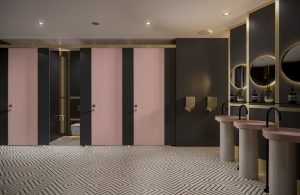Bog Standard

Two-thirds of respondents agree that the cleanliness of a bathroom reflects the quality of the food served.
The Washroom 2019 report, commissioned by the Formica Group, asked 2,000 respondents in the UK for their most common toilet bugbears and their best and worst experiences.
The report also seeks to understand the features, decor and colours the public like to see in hospitality washrooms and explore how those factors influence everyday decisions.
Overall, this second report from the Group finds that the British public is underwhelmed with toilets in places serving food and drink, with only 5% considering them ‘spotless’.
At 54% trains top the list of washrooms people are reluctant to use followed by nightclubs (25%), motorway service stations and stadia (both 22%) with 21% citing fast-food outlets. Over half (58%) of those surveyed say that these facilities were “too dirty”.
The biggest issues identified were hygiene and bad smells, with poor maintenance being another major complaint.
“Close to half (46%) thought the facilities were ‘too smelly’ and almost as many (44%) cited poor maintenance as a reason for their reluctance to use the toilets,” states the report.
Over a quarter of respondents admitted to checking the toilets before deciding where to drink or eat, demonstrating the kind of impact getting this space right can have on small businesses.
“Keeping washrooms pristine – well-maintained surfaces and cubicles or at least, clean and fragrant – should be a priority for any business owner in the hospitality sector.”
Clean enough to eat your dinner
A clear link between the quality of public washrooms and the perceived quality of the establishment overall was found with two-thirds of respondents agreeing that the cleanliness of a bathroom reflects the quality of the food served.
“Over half (56%) go as far as to say that the state of a bathroom has lead them to never return to that establishment; the impact of washrooms on customer opinion cannot be overstated.”
The design and aesthetic of a bathroom also leaves its stamp and can affect a bathroom-user’s conscious or subconscious perception of comfort. Two out of five people surveyed affirmed that style and décor impacted whether they were comfortable using the facilities.
“Bright, spacious bathrooms with large mirrors and sinks were almost universally considered positive features,” the report states.
“Our survey has shown that light colours are favourable in hospitality establishment washrooms, but white, grey and beige tones show up scuffs easily and may need frequent maintenance. Why not use a darker colour near the floor and lighter shades up high?”
While word-of-mouth and Food Standards Agency hygiene ratings are factors in choosing a place to dine in the UK, social media and online reviews are also increasingly influential.
Give the people what they want
As part of the survey people were also asked what they really want to see in a bathroom. The most popular features were those that improved hygiene as exemplified by the ‘hands-free’ toilet experience (71%), preferred by two-thirds of respondents while “reduced noise hand-dryers were generally considered not very important (41%)”.
42% considered soundproofing to be “somewhat important” and half (48%) felt the same way about improved ventilation.
However excessive frills such as Japanese-style wash and dry technology were considered unnecessary. Instead, there was a high demand for basic privacy with soundproofing considered to be ‘somewhat important’ by 42%.
Unisex toilets have yet to gain popularity. A mere 5% “don’t mind them” and around half of respondents – male and female – prefer gender-specific toilets. Women in particular see the washroom as a space where you should be able to feel at ease and tend to believe that any toilet apart from their own will be of questionable hygiene.
The survey also found that while 41% of men say they spend under 30 seconds using the bathroom, the majority of women spent between one and four minutes in there.








